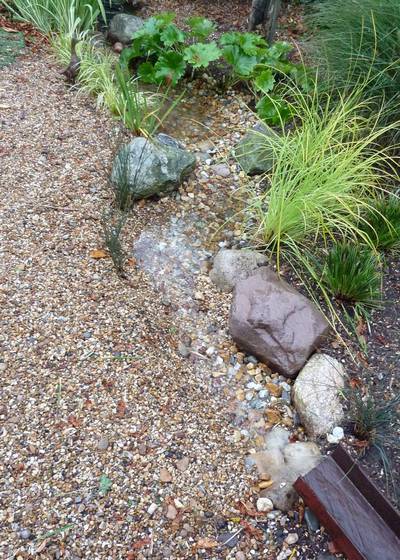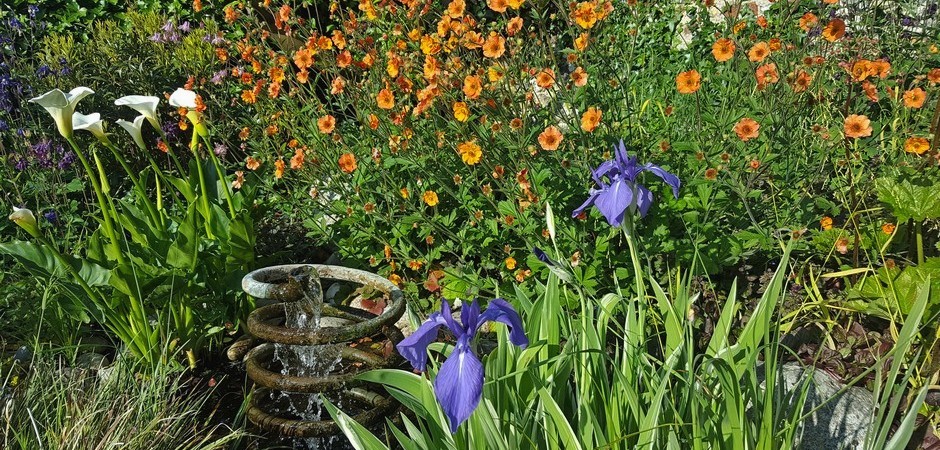
Rain gardens are a relatively new approach on how to deal with water in the environment. In the last 10-15 years, there has been a big rise in the use of SUDS (sustainable urban drainage systems), the practice of delaying the entry of rainwater into the drainage system by the use of swales, ditches and ponds. However, this is generally the domain of engineers who are mostly concerned with their pipework; rain gardens, on the other hand, do the same thing, but are equally concerned with aesthetics and ecology – and so are far more exciting. Easily applied to the domestic situation, but the concept works just as well in urban and commercial design. In fact, WSUD – Water Sensative Urban Design – looks set to take on this wider role in the municipal environment, possibly replacing SUDS.
Having built many water gardens in my life, I decided (in 2010) it was time to build a rain garden in my own home, where I could enjoy it and also monitor its performance. These pictures show the just-completed garden, only a few months old; it also rained right on cue and appeared to be working well!

So what is the “philosophy” of a rain garden: why build one? Well, flood prevention is one answer; if you have ever experienced floods in your area, you have directly or indirectly contributed to them. If the rain didn’t fall on your actual roof, it fell on part of the urban fabric that has been built to support you. Another answer is to re-charge ground water supplies; many urban areas have groundwater levels that are dropping due to the fact that rain cannot permeate the land where it falls (95% of urban land is impermeable). Water tables are also dropping because we are abstracting water far more quickly than it is being replenished.
Rain gardens are a great way to re-connect with nature, opening you up to the experience of natural rhythms and process. It will sit there quietly in hot weather, dry, yet still a micro climate for flora and fauna that like a little extra moisture, in the lowest parts, providing free drainage to the drier areas. When it rains, though, the garden comes to life; water from the roof of your house, instead of disappearing down the drain, starts running into the areas of dips and dry ponds you have created, perhaps having topped up your rainwater butts first. Gradually pools start appearing and maybe in a heavy downpour, water starts running between them. How long it then takes to dissipate will depend upon your soil type; I’m on an alluvial soil, so it is very free draining; on heavy clay it might take days for the water to disperse, and this might mostly be from evaporation. This is good too as it helps re-charge the local hydrological cycle, which is also severly lacking sufficient moisture content, and may well be a significant but overlooked driver of climate change. If you have limited space or can’t allow water to rise beyond a certain level (after all, you don’t want to move the flood potential from somewhere further away, to your own home!), then you might need an overflow which puts any surplus water back to drain, or perhaps (and preferably) to another part of the garden. You will have still considerably delayed the timing of water going to drain, as well as the volume.

In my garden, I have disconnected one of the main roof downpipes (which it turned out was blocked) and used an old steel channel I found when they demolished the adjacent dairy. We have old cast-iron downpipes so I bought a 90° bend and fitted that to direct the water into the chute. I then dug a channel and partly lined the bottom with plastic, because our ground is very free draining and I wanted to connect this to an existing small water feature, so that this was topped up by rainfall. Surplus water is then dispersed to the sides, through the planting. If I were designing this from scratch, I would put the pond before the raingarden, so this was topped up first. Having said that, this section of the garden has always been incredibly dry and I’m hoping that the ground will, over time, recharge itself and things will grow better. This dryness is evidenced by the fact that we have a young fig growing well, right by the downpipe.
In periods of heavy and prolonged downpours, it may be that the pond will overflow; this will happen at the back and will disperse out away from the house under the bushes. With our soil, I don’t see the need for any further overflow drainage.
The roof section that feeds this downpipe is about 50m2, south facing. We get on average 50cm rain per year, so this should capture 25m3/year. This morning in light/medium rainfall, the chute was delivering 3 litres/minute (nowhere near the rate of a hosepipe). The rain garden is about four metres long and I’m not sure how to measure the drainage rate of soil, apart from having the plasticity index measured in a lab but over time I will use these figures to try and calculate how much water is passing through the system; in theory 25m3/year.

I was sent this picture (right) of a rain garden I designed for a client around the same time that I made mine. What a great picture, it gets right to the heart for so many issues about life, play, learning, experience, the elements. We tend to over-design our environments for safety, yet end up sanitizing them to the point where life becomes uneventful and we loose the richness and diversity that being connected to nature gives us. On a rainy day most kids are sat in front of the TV; I think this as a much better option…
The soil in this raingarden is a heavy clay and so holds the water for longer. It is bigger than mine and would need to be to increase the percolation area. You can also see that mine is more planted and this is again a condition of its function – theirs was designed to be a play space for the children (which is why I’m so pleased that it is successful). When they have grown up, it can be planted more intensely. It also created a feature in an otherwise rather awkward, narrow, North-facing space.
Rainwater management isn’t just for large commercial or public-realm sites, it can be done in your own garden too, with multiple benefits to environment, garden, wildlife and of course, you.
First published in 2011

